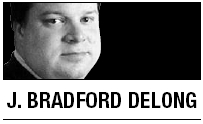BERKELEY ― Three times in my life (so far), I have concluded that my understanding of the world was substantially wrong. The first time was after the passage in 1994 of the North America Free Trade Agreement (NAFTA), when the flow of finance to Mexico to build factories to export to the largest consumer market in the world was overwhelmed by the flow of capital headed to the United States in search of a friendlier investment climate. The result was the Mexican peso crisis of later that year (which I, as U.S. assistant secretary of treasury, had to help contain).

My second epiphany came in the fall and winter of 2008, when it became clear that large banks had no control over either their leverage or their derivatives books, and that the world’s central banks had neither the power nor the will to maintain aggregate demand in the face of a large financial crisis.
The third moment is now. Today, we face a nominal demand shortfall of 8 percent relative to the pre-recession trend, no signs of gathering inflation and unemployment rates in the North Atlantic region that are at least three percentage points higher than any credible estimate of the sustainable rate. And yet, even though politicians who fail to safeguard economic growth and high employment tend to lose the next election, leaders in Europe and the U.S. are clamoring to enact policies that would reduce output and employment in the short run.
Am I missing something here?
I had thought that the fundamental issues in macroeconomics were settled in 1829. Back then, even Jean-Baptiste Say no longer believed in Say’s Law of business-cycle frequencies. He knew very well that a financial panic and excessive demand for financial assets could produce deficient demand for currently-produced commodities and for labor, and that while such a short-run breakdown of Say’s Law might be temporary, it was nonetheless highly destructive.
Armed with that insight, the disease of the business cycle should be addressed in one or more of three ways.
― Don’t go there in the first place. Avoid whatever it is ― whether an external drain under the gold standard or a collapse of long-term wealth as with the collapse of the dot-com bubble or a panicked flight to safety as in 2007-08 ― that creates a shortage of, and excess demand for, financial assets.
― If you fail to avoid the problem, then have the government step in and spend on currently produced goods and services in order to keep employment at its normal levels to offset private-sector spending cuts.
― If you fail to avoid the problem, then have the government create and provide the financial assets that the private sector wants to hold in order to get the private sector to resume its spending on currently produced goods and services.
There are a great many subtleties to how a government should attempt to pursue each of these policy options. Attempts to carry out one of the three may exclude or interfere with attempts to carry out the others. And, if inflationary expectations become embedded in an economy, it may be impossible for any of the three cures to work. But that is not our situation today.
Likewise, if the perceived creditworthiness of the government is shaken, then intervention from some outside lender of last resort might be essential for either the second or third cure to work. But that, too, is not the situation today in the core economies of the North Atlantic.
Yet, somehow, all three of these cures are now off the table. There is no likelihood of reforms of Wall Street and Canary Wharf aimed at diminishing the likelihood and severity of any future financial panic, and no likelihood of government intervention to restore the normal flow of risky finance through the banking system. Nor is there any political pressure to expand or even extend the anemic government stimulus measures that have been undertaken.
Meanwhile, the European Central Bank is actively looking for ways to shrink the supply of financial assets that it provides to the private sector, and the U.S. Federal Reserve is under pressure to do the same. In both cases, it is claimed that further expansionary asset-provision policies run the risk of igniting inflation.
Yet no likelihood of inflation can be seen when tracking price indexes or financial-market readings of forecast expectations. And no approaching government debt crisis in the core economies can be seen when tracking government interest rates.
Nevertheless, when you listen to the speeches of policymakers on both sides of the Atlantic, you hear presidents and prime ministers say things like: “Just as families and companies have had to be cautious about spending, government must tighten its belt as well.”
And here we reach the limits of my mental horizons as a neoliberal, as a technocrat and as a mainstream neoclassical economist. Right now, the global economy is suffering a grand mal-seizure of slack demand and high unemployment. We know the cures. Yet we seem determined to inflict further suffering on the patient.
By J. Bradford DeLong
J. Bradford DeLong, a former U.S. assistant secretary of treasury, is a professor of economics at the University of California at Berkeley and a research associate at the National Bureau for Economic Research. ― Ed.
(Project Syndicate)







![[Today’s K-pop] Blackpink’s Jennie, Lisa invited to Coachella as solo acts](http://res.heraldm.com/phpwas/restmb_idxmake.php?idx=644&simg=/content/image/2024/11/21/20241121050099_0.jpg)
